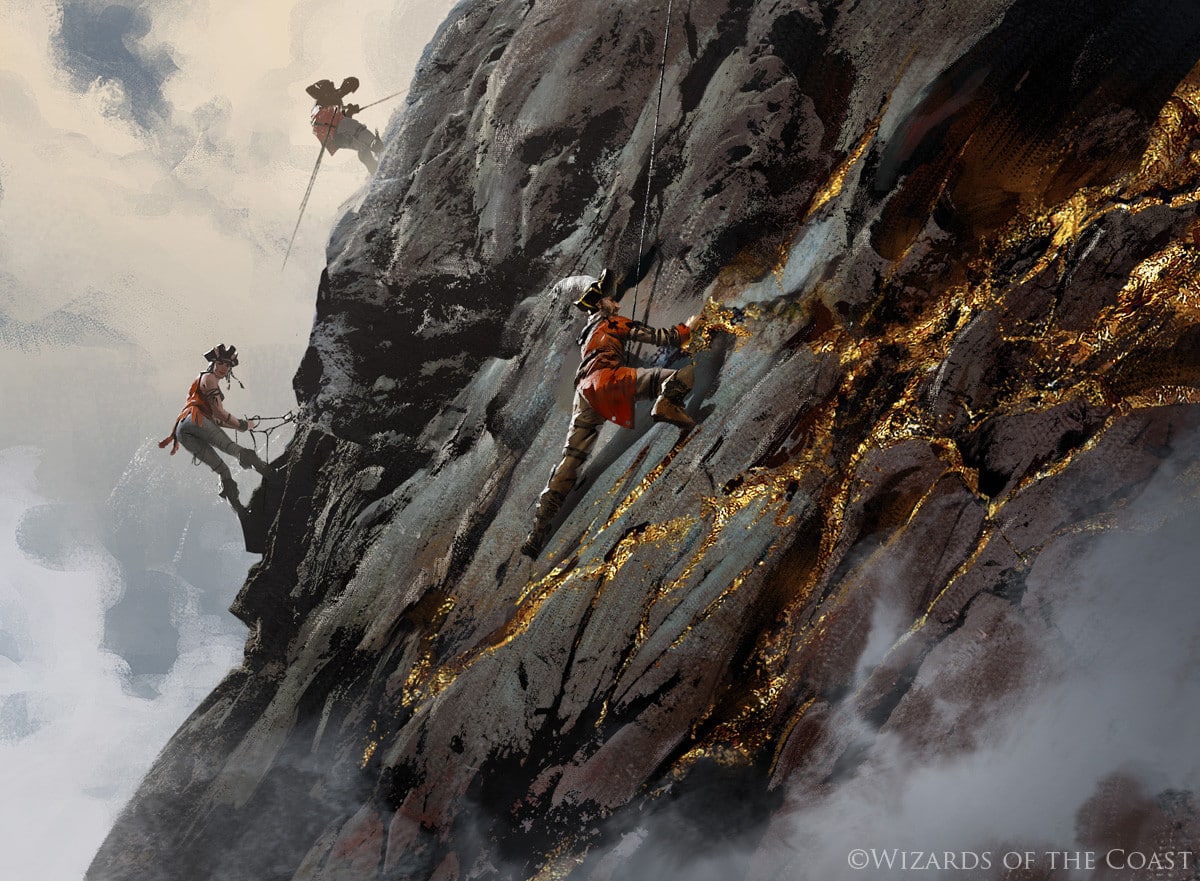Climbing Speed 5e
Published on December 17, 2022, Last modified on March 3rd, 2024
If you’re looking to add a bit of vertical movement to your D&D 5e repertoire, good ol’ fashion climbing may be the best way to accomplish this.

Grzegorz Rutkowski - Wizards of the Coast - Brass’s Bounty
Table of Contents
Climbing Speed in D&D
When you’re adventuring, you’re bound to need to climb something. Need to reach a treasure chest high atop a mountain? Climbing. Gotta descend into a dark cave to kill a dragon? Climbing. In D&D 5e, they’ve made it so that anyone can do climbing, but how exactly does it work these days?
Dungeons & Dragon’s 5th Edition simplified a lot of the overhead that came with older editions, cleaning up some confusing rules and making the game much more accessible than before. This is especially true for many of the skills we saw in 3.5e, which were confusing and honestly had too many options, including skill checks for things such as climbing. Thankfully, in today’s world, we’ve gotten a much simpler way to traverse the globe.
What is Climbing Speed in 5e?
By default, most characters don’t have a set climbing speed. As per the Player’s Handbook, “while climbing or swimming, each foot of movement costs one extra foot unless a creature has a climbing or swimming speed.” Essentially, having a climbing speed erases this formula and sets your character at a pace that is at or above this average speed.
How does Climbing Speed work in 5e?
The basic formula is pretty simple. Each foot of movement when climbing costs an extra foot (or two if it’s difficult terrain). This means that a character with no natural climbing speed and a 30ft walking speed will be able to move 15ft while climbing.
It’s a pretty straightforward mechanic for most characters. Those with a natural climbing speed, or one granted from a spell or ability, generally have a much higher climbing speed. It’s usually pretty close to base walking speeds for most characters, making them twice as fast as those without.
Athletics Checks for Climbing
Some surfaces may require an Athletics check to climb successfully. These surfaces are particularly tricky to climb, such as:
- Vertical wall with minimal handholds
- Loose rocks or other treacherous terrain
- Wet or slick surfaces
- Overhangs
The DC for these checks is up to the DM, though one of the easiest ways to reduce the DC is to somehow position a rope so it can grant you a better surface to climb.
How do Classes Handle Climbing Speed Differently?
Most classes and subclasses don’t have any way to affect climbing speed. In most cases, classes have some way to gain a flying speed of some kind, which often invalidates climbing speed. However, there are some exceptions, like:
Path of the Beast Barbarians
These barbarians can gain a climbing speed equal to their walking speed with their 6th-level Beastial Soul ability.
Druid
Druids can wild shape into a number of creatures that get a climbing speed, the giant wolf spider being chief amongst them.
Rangers
By default, with the Deft Explorer ability, rangers gain a climbing speed and swimming speed equal to their walking speed.
Rogues
Scout: While they don’t have any natural climbing speeds, the Scout’s 9th level ability adds 10ft to a character’s climbing speed, if they have one. This is one of the few ways to increase it beyond adding more to your walking speed.
Thief: Second-Story Work allows you to climb without extra movement costs.
Mechanics That Affect Climbing Speed in 5e
Similarly to classes, there is a much broader focus on giving characters flying speed over climbing speed for the most part. However, some racial traits will affect climbing speed in some way and a single feat.
Tabaxi
Both the Volo’s Guide to Monsters and Mordenkainen’s Monsters of the Multiverse grant Tabaxi a climbing speed, with Volo’s being 20ft and MoM being equal to their walking speed.
Grung
While they only exist in the Extra Life 2017 special book, these sticky froggy boys have a natural climbing speed of 25ft.
Dhampir
This lineage allows you to have a climbing speed equal to your walking speed without restrictions.
Simic Hybrid
This race allows you to pick up the Nimble Climber enhancement at the 1st or 5th level, allowing you to have a climb speed equal to your walk speed.
Athlete (feat)
As written, this feat lets you climb without halving your speed. This doesn’t give you a natural climbing speed, but it’s pretty good nonetheless.
Spider Climb
At a 2nd-level spell slot, spider climb is one of the best ways to get to high, hard-to-reach places before spellcasters get access to fly. This spell remains a viable option even after fly is unlocked because you can climb on vertical and upside down surfaces while keeping your hands free, allowing for tons of movement options without hindering your offensive abilities.
Climbing the Summit
Well, we’re finally here. We climbed down to the end of the article! Climbing is an essential part of D&D 5E, as we all need to climb up or down something at some point. While all characters can climb, it’s not as common to see them with an actual climbing speed, allowing them to traverse terrain much faster.
How do you feel about climbing speed? Are there any tips or features that I missed? Let us know in the comments below!
Climbing Speed 5e FAQs
Can Changelings copy climbing or flying speed with Change Appearance?
Unfortunately, changelings aren’t able to gain climbing speeds (or other types) when they use their Change Appearance feature.
Is climbing an action or a movement in 5e?
Within 5e, climbing is a part of movement and falls under a character’s move actions.
